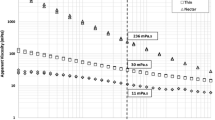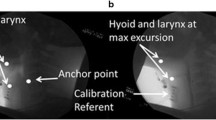Abstract
The contribution of hyoid and laryngeal movement deficits to penetration or aspiration in dysphagia is unclear, partly due to large variations in normal hyolaryngeal kinematics for swallowing. In healthy volunteers, laryngeal and hyoid kinematics relate to the requirements for laryngeal vestibule closure suggesting a central schematic control of movement magnitude and patterning for airway protection. Our first aim was to determine if patients with severe dysphagia showed evidence of an impaired swallowing schema, by examining if their kinematic measures were related to their hyolaryngeal space before swallow onset, and if hyolaryngeal movement synchrony for vestibule closure was disrupted. Our second aim was to determine the kinematic measures that predicted bolus penetration and aspiration in dysphagia. The methods included two-dimensional measures of the hyoid and laryngeal anterior and superior displacement and velocity, and the change in laryngeal vestibule area made from videofluoroscopic swallow recordings of 21 healthy volunteers and 21 patients with dysphagia on tube feeding secondary to the stroke or head and neck cancer. The results demonstrated that the patients did not adapt their hyolaryngeal movements during swallowing to their initial hyolaryngeal space. Further, none of the patients’ measures of hyoid or laryngeal peak velocity timing were synchronized with vestibule closure, demonstrating a disorganized movement patterning. Laryngeal elevation peak velocity independently predicted penetration and aspiration. In conclusion, the central schema for swallowing patterning was disturbed, impairing the integration of kinematic actions for airway protection in severe dysphagia, while laryngeal peak elevation velocity predicted penetration and aspiration on patient swallows.







Similar content being viewed by others
References
Molfenter SM, Steele CM. Physiological variability in the deglutition literature: hyoid and laryngeal kinematics. Dysphagia. 2011;26:67–74.
Kim YH, Oh BM, Jung IY, Lee JC, Lee GJ, Han TR. Spatiotemporal characteristics of swallowing in Parkinson's disease. Laryngoscope. 2014;125(2):389–95.
Kendall KA, Leonard RJ. Hyoid movement during swallowing in older patients with dysphagia. Arch Otolaryngol Head Neck Surg. 2001;127:1224–9.
Bingjie L, Tong Z, Xinting S, Jianmin X, Guijun J. Quantitative videofluoroscopic analysis of penetration-aspiration in post-stroke patients. Neurol India. 2010;58:42–7.
Paik NJ, Kim SJ, Lee HJ, Jeon JY, Lim JY, Han TR. Movement of the hyoid bone and the epiglottis during swallowing in patients with dysphagia from different etiologies. J Electromyogr Kinesiol. 2008;18:329–35.
Sundgren P, Maly P, Gullberg B. Elevation of the larynx on normal and abnormal cineradiogram. Br J Radiol. 1993;66:768–72.
Molfenter SM, Steele CM. Use of an anatomical scalar to control for sex-based size differences in measures of hyoid excursion during swallowing. J Speech Lang Hear Res. 2014;57:768–78.
Wong SM, Domangue RJ, Fels S, Ludlow CL. Evidence that an internal schema adapts swallowing to upper airway requirements. J Physiol. 2017;595:1793–814.
Steele CM, Cichero JA. Physiological factors related to aspiration risk: a systematic review. Dysphagia. 2014;29:295–304.
Kraaijenga SA, van der Molen L, Heemsbergen WD, Remmerswaal GB, Hilgers FJ, van den Brekel MW. Hyoid bone displacement as parameter for swallowing impairment in patients treated for advanced head and neck cancer. Eur Arch Otorhinolaryngol. 2017;274:597–606.
Molfenter SM, Steele CM. Kinematic and temporal factors associated with penetration-aspiration in swallowing liquids. Dysphagia. 2014;29:269–76.
Nagy A, Molfenter SM, Peladeau-Pigeon M, Stokely S, Steele CM. The effect of bolus volume on hyoid kinematics in healthy swallowing. BioMed Res Int. 2014. https://doi.org/10.1155/2014/738971.
Kahrilas PJ, Lin S, Rademaker AW, Logemann JA. Impaired deglutitive airway protection: a videofluoroscopic analysis of severity and mechanism. Gastroenterology. 1997;113:1457–64.
Wang TG, Chang YC, Chen WS, Lin PH, Hsiao TY. Reduction in hyoid bone forward movement in irradiated nasopharyngeal carcinoma patients with dysphagia. Arch Phys Med Rehabilit. 2010;91:926–31.
Zhang J, Zhou Y, Wei N, Yang B, Wang A, Zhou H, Zhao X, Wang Y, Liu L, Ouyoung M, Villegas B, Groher M. Laryngeal elevation velocity and aspiration in acute ischemic stroke patients. PLoS ONE. 2016;11:e0162257.
Pearson WG Jr, Taylor BK, Blair J, Martin-Harris B. Computational analysis of swallowing mechanics underlying impaired epiglottic inversion. Laryngoscope. 2016;126:1854–8.
Vose A, Humbert I. “Hidden in Plain Sight”: a descriptive review of laryngeal vestibule closure. Dysphagia. 2018;34(3):281–9.
van der Kruis JG, Baijens LW, Speyer R, Zwijnenberg I. Biomechanical analysis of hyoid bone displacement in videofluoroscopy: a systematic review of intervention effects. Dysphagia. 2011;26:171–82.
Veljan D. The 2500-year-old Pythagorean Theorem. Math Mag. 2000;73:259–72.
Kang BS, Oh BM, Kim IS, Chung SG, Kim SJ, Han TR. Influence of aging on movement of the hyoid bone and epiglottis during normal swallowing: a motion analysis. Gerontology. 2010;56:474–82.
Martin-Harris B, Brodsky MB, Michel Y, Lee F, Walters B. Delayed initiation of the pharyngeal swallow: normal variability in adult swallows. J Speech Lang Hear Res. 2007;50:585–94.
Stephen JR, Taves DH, Smith RC, Martin RE. Bolus location at the initiation of the pharyngeal stage of swallowing in healthy older adults. Dysphagia. 2005;20:266–72.
Mendell DA, Logemann JA. Temporal sequence of swallow events during the oropharyngeal swallow. J Speech Lang Hear Res. 2007;50:1256–71.
Logemann JA, Pauloski BR, Rademaker AW, Colangelo LA, Kahrilas PJ, Smith CH. Temporal and biomechanical characteristics of oropharyngeal swallow in younger and older men. J Speech Lang Hear Res. 2000;43:1264–74.
Rosenbek JC, Robbins JA, Roecker EB, Coyle JL, Wood JL. A penetration-aspiration scale. Dysphagia. 1996;11:93–8.
Steele CM, Grace-Martin K. Reflections on clinical and statistical use of the penetration-aspiration scale. Dysphagia. 2017;32:601–16.
Jacob P, Kahrilas PJ, Logemann JA, Shah V, Ha T. Upper esophageal sphincter opening and modulation during swallowing. Gastroenterology. 1989;97:1469–78.
Yokoyama M, Mitomi N, Tetsuka K, Tayama N, Niimi S. Role of laryngeal movement and effect of aging on swallowing pressure in the pharynx and upper esophageal sphincter. Laryngoscope. 2000;110:434–9.
Cook IJ, Dodds WJ, Dantas RO, Massey B, Kern MK, Lang IM, Brasseur JG, Hogan WJ. Opening mechanisms of the human upper esophageal sphincter. Am J Physiol. 1989;257:G748–G759759.
Pearson WG Jr, Davidoff AA, Smith ZM, Adams DE, Langmore SE. Impaired swallowing mechanics of post radiation therapy head and neck cancer patients: a retrospective videofluoroscopic study. World J Radiol. 2016;8:192–9.
Kahrilas PJ, Logemann JA, Krugler C, Flanagan E. Volitional augmentation of upper esophageal sphincter opening during swallowing. Am J Physiol. 1991;260:G450–G456456.
Kahrilas PJ, Lin S, Chen J, Logemann JA. Oropharyngeal accommodation to swallow volume. Gastroenterology. 1996;111:297–306.
Vandaele DJ, Perlman AL, Cassell MD. Intrinsic fibre architecture and attachments of the human epiglottis and their contributions to the mechanism of deglutition. J Anat. 1995;186(Pt 1):1–15.
Logemann JA, Kahrilas PJ, Cheng J, Pauloski BR, Gibbons PJ, Rademaker AW, Lin S. Closure mechanisms of laryngeal vestibule during swallow. Am J Physiol. 1992;262:G338–G34444.
Ludlow CL, Humbert I, Saxon K, Poletto C, Sonies B, Crujido L. Effects of surface electrical stimulation both at rest and during swallowing in chronic pharyngeal Dysphagia. Dysphagia. 2007;22:1–10.
Jean A. Brain stem control of swallowing: neuronal network and cellular mechanisms. Physiol Rev. 2001;81:929–69.
Acknowledgements
The authors would like to thank Ms Hui Hui Gan for her contribution as the second rater for kinematic measurements.
Funding
The first author received funding from the Singapore General Hospital for her doctoral studies. Partial funding for this study came from the American Speech-Language-Hearing Foundation Graduate Student Scholarship awarded to the first author in 2013.
Author information
Authors and Affiliations
Corresponding author
Ethics declarations
Conflict of interest
The authors declare that they have no conflicts of interest.
Informed Consent
Informed consent was obtained from all individual participants included in this study.
Additional information
Publisher's Note
Springer Nature remains neutral with regard to jurisdictional claims in published maps and institutional affiliations.
Rights and permissions
About this article
Cite this article
Wong, S.M., Kamarunas, E. & Ludlow, C.L. Impaired Movement Scaling and Reduced Synchrony with Vestibule Closure Characterize Swallowing in Severe Dysphagia. Dysphagia 35, 643–656 (2020). https://doi.org/10.1007/s00455-019-10067-0
Received:
Accepted:
Published:
Issue Date:
DOI: https://doi.org/10.1007/s00455-019-10067-0




